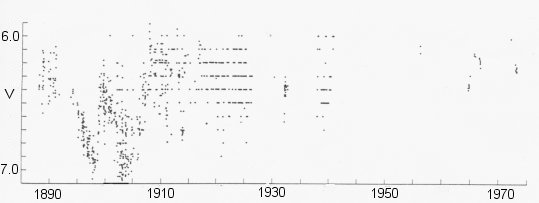 The "historic light curve" of X Persei from 1888 to 1974 shows it
fading twice from magnitude 6 (the scale on the left labelled "V"
for "apparent visual magnitude") to 7 around
the turn of the 20th century. It then more or less stabilized near
its brighter state (that with the surrounding disk). The
observations from 1910 to 1960 show such scatter that considerable
activity could be hidden. The disk disappeared and the star
faded again between 1989 and 1991. From an article in the Publications
of the Astronomical Society of the Pacific by D. Mook, F.
Boley, C. Foltz, and D. Westpfahl).
The "historic light curve" of X Persei from 1888 to 1974 shows it
fading twice from magnitude 6 (the scale on the left labelled "V"
for "apparent visual magnitude") to 7 around
the turn of the 20th century. It then more or less stabilized near
its brighter state (that with the surrounding disk). The
observations from 1910 to 1960 show such scatter that considerable
activity could be hidden. The disk disappeared and the star
faded again between 1989 and 1991. From an article in the Publications
of the Astronomical Society of the Pacific by D. Mook, F.
Boley, C. Foltz, and D. Westpfahl).
|
 The "historic light curve" of X Persei from 1888 to 1974 shows it
fading twice from magnitude 6 (the scale on the left labelled "V"
for "apparent visual magnitude") to 7 around
the turn of the 20th century. It then more or less stabilized near
its brighter state (that with the surrounding disk). The
observations from 1910 to 1960 show such scatter that considerable
activity could be hidden. The disk disappeared and the star
faded again between 1989 and 1991. From an article in the Publications
of the Astronomical Society of the Pacific by D. Mook, F.
Boley, C. Foltz, and D. Westpfahl).
The "historic light curve" of X Persei from 1888 to 1974 shows it
fading twice from magnitude 6 (the scale on the left labelled "V"
for "apparent visual magnitude") to 7 around
the turn of the 20th century. It then more or less stabilized near
its brighter state (that with the surrounding disk). The
observations from 1910 to 1960 show such scatter that considerable
activity could be hidden. The disk disappeared and the star
faded again between 1989 and 1991. From an article in the Publications
of the Astronomical Society of the Pacific by D. Mook, F.
Boley, C. Foltz, and D. Westpfahl).